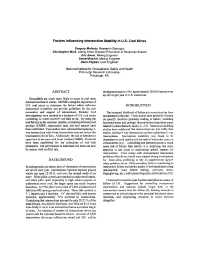Mining Publication: Factors Influencing Intersection Stability in U.S. Coal Mines
Original creation date: August 1998
Groundfalls are much more likely to occur in coal mine intersections than in entries. NIOSH is using the experience of U.S. coal mines to determine the factors which influence intersection instability and provide guidelines for the safe excavation and support of intersections. Detailed field investigations have resulted in a database of U.S. coal mines containing 12 mines and 639 roof falls so far. By using the roof fall rate as the outcome variable, correlations between roof geology (CMRR), intersection span, and roof support have been established. Case studies have indicated that replacing 3-way intersections with 4-way intersections may not reduce the total number of roof falls. Additionally, the size of intersection spans tend to decrease with lower (weaker) CMRR. Protocols have been established for the collections of roof bolt parameters. The performance of individual roof bolts can now be tracked with roof fall rate.
Authors: GM Molinda, C Mark, ER Bauer, DR Babich, DM Pappas
Conference Paper - August 1998
NIOSHTIC2 Number: 20000095
In: Proceedings of the 17th International Conference on Ground Control in Mining, Peng SS, ed., Morgantown, WV: University of West Virginia, 1998 Aug; pp. 267-275
See Also
- Analysis of Roof Bolt Systems
- Comparison of Ground Conditions and Ground Control Practices in the United States and Australia
- Development and Application of the Coal Mine Roof Rating (CMRR)
- Diagnosing and Controlling Moisture-Sensitive Roof in Coal Mines
- The Introduction of Roof Bolting to U.S. Underground Coal Mines (1948-1960): A Cautionary Tale
- Performance Characteristics for Welded Wire Screen Used for Surface Control in Underground Coal Mines
- Potential of Roof Screening to Reduce Workers’ Compensation Cost
- Preventing Falls of Ground in Coal Mines With Exceptionally Low-Strength Roof: Two Case Studies
- Proceedings: New Technology for Coal Mine Roof Support
- Roof Screening: Best Practices and Roof Bolting Machines
- Page last reviewed: 9/21/2012
- Page last updated: 9/21/2012
- Content source: National Institute for Occupational Safety and Health, Mining Program


 ShareCompartir
ShareCompartir
